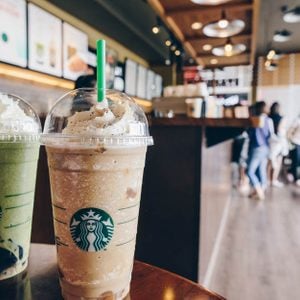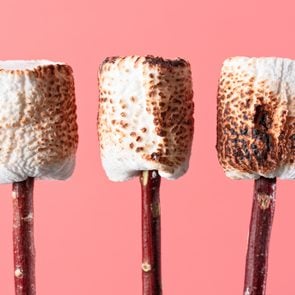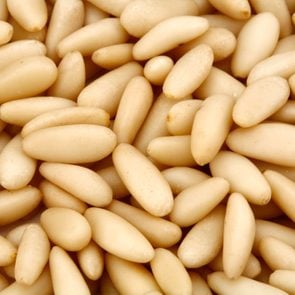What Is Bubble Tea, Exactly?
Updated: Nov. 28, 2022

Here's everything you ever wanted to know about boba, the fun and customizable Taiwanese bubble tea.
When bubble tea was first introduced to the West, you could get it only in cheery mom-and-pop shops in big-city Chinatowns and Koreatowns. And while Asians and Asian Americans have been drinking bubble tea (aka boba) for decades, this beloved Taiwanese drink has been steadily garnering global popularity. A bit of food facts trivia: The bubble tea market was valued at just over $2 billion in 2019 and is estimated to surpass $3 or $4 billion by 2027. But what is bubble tea? (You know, aside from your soon-to-be-favorite drink.)
Classic bubble tea is black tea brewed with milk and sugar, then poured over ice and tapioca balls. But it can come in an array of other delicious flavors, using a base of everything from green tea, chai tea or other loose-leaf teas, to fresh fruit juice, and featuring fun toppings like mochi.
With the added fun of slurping up sweet and chewy tapioca balls through a colorful fat straw, bubble tea is like a beverage and dessert combined into one aesthetically pleasing treat. For those who haven’t been inducted into the bubble tea fan club yet, it’s an absolute must-try.
When was bubble tea created?
Invented in the tea houses of Taiwan in the ’80s, bubble tea has had a comparatively short history when you consider the centuries of tea drinking in Asia. You’ll find it under a few names: bubble tea, boba, boba naicha, and milk tea.
Since then, bubble tea has come a long way in terms of variety, creativity, and availability. (Case in point: It even appeared on Dunkin’s summer 2021 menu.) As more and more bubble tea shops pop up, we’re seeing innovative flavor combinations, tasty toppings, and vegan-friendly and organic options. Even if you can’t travel all the way to Taipei to go on a bubble tea crawl (add it to your travel bucket list!), you can get fresh bubble tea delivered right to your doorstep in many major cities. You can even buy DIY bubble tea kits, the perfect gift for tea lovers and boba fanatics.
What is bubble tea, and why is it so popular?
Boba begins with a tea base—black, green, matcha, or some other pick—that’s then combined with milk and sweetener. Ingredients differ from one restaurant to the next, but many offer bubble tea made with plant-based milks like almond and coconut.
The drink is crafted by ladling tapioca balls (more on those in a minute) into a cup and pouring the sweet, milky tea over the top. Some shops use a machine to seal the cup with heated cellophane so that it’s easy to tote around without spillage. When you’re ready to sip, simply stick the oversized straw through the cellophane “lid.”
Drinking bubble tea is an experience. As the tea flavors dance along your tongue, you can chew the sweet tapioca pearls. When you do, you’ll instantly understand why so many people love the drink: It’s a super-fun and addictive combination, with the bouncy, springy texture reminiscent of mochi or candied jellies.
Most bubble tea shops allow you to customize ice levels and sugar levels. If you want more bang for your buck, you can request less ice, but it may not be as refreshing. And while boba is typically served as a cold beverage, you can also choose to order it piping hot to warm your bones on cold days.
What are bubble tea balls?
A sign of a good bubble tea is the quality of its tapioca balls, which are also known as tapioca pearls, bubbles, or boba. Made from tapioca starch extracted from cassava root, these marble-sized balls are naturally gluten free. The traditional black pearls you suck up with your jumbo straw are boiled and caramelized, but they start white and relatively flavorless. They get their beautiful dark color from soaking in a caramelized brown sugar syrup.
Bubble tea balls have to be timed perfectly in order to get the right consistency and freshness. Boil the tapioca too long, and they become mushy and shapeless. Leave them sitting out for too long, and they get hard and impossible to chew. If you’d like to try making your own bubble tea at home, you can buy pre-made tapioca pearls from an Asian grocery store or even make your own from scratch using tapioca starch.
A word to the wise: Be careful to not sip too hard. You could suck the tapioca pearls directly into your throat. It can be a bit of a choking hazard for the uninitiated, as proven by many TikTok videos of Westerners trying boba for the first time. While bubble tea is a safe and a fun treat for kids, be sure to supervise your little ones while drinking.
What does bubble tea taste like?
Bubble teas can come in many different flavors, but the classic flavor combines the robust complexity of black tea with the creamy richness of milk and the sweetness of brown sugar tapioca. Of course, the drink will taste slightly different if you order yours made with green, Earl Grey, jasmine, chai, or oolong teas.
On most bubble tea menus, you’ll also find refreshing, caffeine-free fruit-flavored options. Try some of the flavors beloved in Asia, like lychee, white peach, yuzu, and yakult. Also worth a sip is sweet taro, which has a lovely purple shade and a nutty, vanilla flavor.
If you’re a slow drinker and prefer to savor your beverages, ask for less ice so it doesn’t dilute the flavor of your boba as it melts. And if you’re sensitive to texture, and chewy foods are not really for you, don’t worry! These days, you can top your tea with all sorts of different toppings—flavored jellies, sweet adzuki beans, fresh fruit, ice cream, rich custard pudding, and more.
What is the best bubble tea flavor?
So, you have the answer to “What is bubble tea?” You’re ready to order. And you have no idea which option to pick. Your best bet is to go with your gut—or at least the tea flavor you most adore.
Classic milk tea is the most traditional and a go-to for a reason; lots of people consider it the best bubble tea flavor. But other fan favorites include Thai tea, which uses sweetened condensed milk; sweet taro; matcha; and refreshing honeydew. You can even choose different coffee flavors to get that fix somewhere other than your morning macchiato.
If you’re feeling adventurous, check out different combinations like strawberry matcha, or floral flavors like rose. Or go wild experimenting with different combinations of teas, toppings, ice, and sugar to find your flavor preference.
Is bubble tea unhealthy?
Like any food, the healthfulness of bubble tea depends on what you put in it. Most bubble tea shops offer different sugar levels, such as zero, 25, 50, 75, and 100 percent of the traditional sugar content. If you’re looking to cut processed sugar from your diet, the healthiest option would be to select a loose leaf tea with no sugar at all, and to swap the sweet tapioca pearls for a different topping, such as fresh fruit.
It’s also worth mentioning that tapioca starch is high in carbohydrates, and there are about 12o calories in a cup of bubble tea alone.
There’s also been some confusion surrounding tapioca pearls. Some news outlets have cited a 2012 German study that claimed tapioca balls were toxic and contained carcinogens. But the study was never published, peer reviewed (the gold standard for quality of research), or reproduced. Also, the study misidentified some of the compounds found in tapioca pearls. There is no scientific evidence linking bubble tea to cancer, and tapioca balls are absolutely Food and Drug Administration approved and safe to consume.
While bubble tea, with all of the bells and whistles, is more of a delicious indulgence than an everyday drink, you can customize it to be healthier. Start with 50 percent of the sugar level, try a plant-based milk like oat or almond, and adjust it to your liking. After all, you’ll definitely be coming back for more.
So what is bubble tea? Aside from a refreshing and irresistible drink, it’s a unique way to expand your palate and experience different flavors and textures. Try it out, and support your local Asian American–owned businesses while you’re at it.
Want to learn more about other Asian food favorites? Find out what sashimi is and where wasabi comes from.
Sources:
- Allied Market Research: “Bubble Tea Market”
- Fortune Business Insights: “Bubble Tea Market”
- The Frontiers of Society, Science and Technology: “What Makes Bubble Tea Popular? Interaction between Chinese and British Tea Culture”
- Kung Fu Tea
- USDA FoodData Central: “Lychee Bobas Honeydew Recipe Bubble Tea Green Tea, Lychee Bobas”



